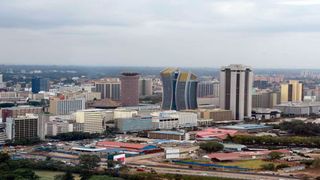
An aerial view of Nairobi Central Businss District in this picture taken on June 30, 2021.
| Diana Ngila | Nation Media GroupNews
Premium
From Mbotela to Maringo to Jericho, Nairobi fights to shake off its colonial past
What you need to know:
- Estates in Nairobi’s Eastlands are mongrels amidst modernity; the city’s unwanted relics.
- Their story, though, is the story of African settlement in Nairobi, an enduring symbols of failed estate renewal programmes.
They stand with defiance and indifference. Their design, fittings and significance something of a throwback. Makongeni, Kaloleni, Bahati, Jericho, Maringo and Mbotela estates in Nairobi are the earliest markers of permanent civilian occupancy in Nairobi. An enduring legacy of imperial Kenya.
Built in the 1940s by the colonial government, these estates were home to public servants, notably railway workers and others in the city council.
Trendy then. Reviled now.
Eighty years later, the houses have been begrimed by the ravages of weather, the weight of seasons and neglect. In a city that boasts architectural wonders of all kinds, these unseemly estates look out of place.
In their mediocre and plain style, and arranged in rows, the severely dilapidated, lookalike houses are like a parade of eccentricity in a modern metropolis. Their lawns are gone, most amenities vandalised and pride forgotten.
As the rest of Nairobi developed, these enclaves remained intact. They are now surrounded by vibrant neighbourhoods with high-rise residential apartments, most which have fairly well-developed water, sanitation and electricity infrastructure.
In all fairness, these estates are mongrels amidst modernity. The city’s unwanted relics.
Their story, though, is the story of African settlement in Nairobi. This mode of housing is the symbol of social exclusion and a reminder of a city that has failed to shake off its colonial hangover. These are the enduring symbols of failed estate renewal programmes.
But who lives here? Are the houses even habitable? What is the cost of rent? How do Nairobi’s colonial estates compare with others elsewhere on the continent? Most importantly, what’s their utility in a modern metropolis?
Phyllis Njeri frowns at the thought of possible eviction from her home in Bahati. It’s not much of a home, though, with the roof collapsing, walls soiled and her toilet now a shell.

A dilapidated house in the low-density Bahati estate in Nairobi on June, 11 2021. This estate is one of the oldest in Nairobi.
Now well in her late 70s, Njeri moved here in 1967 to join her husband who had settled in the city in 1954. For 54 years, her single room in this estate is the only home she has known. It’s here that she has raised her family, and a few grandchildren.
The units here are single rooms, with a shared main door and kitchen for each two households, with only wood partitioning. At Sh1,000 per month per month, rent is far below what most city landlords charge for similar space.
Njeri, though decries exploitation. ‘‘When my husband worked for Posta (Posta Kenya), rent was Sh1. Then it was raised to Sh3,’’ she narrates with nostalgia.
To her, the increase coincided with a decline in the quality of services. ‘‘Our toilets don’t work anymore. We use bucket water to flush waste,’’ she says.
Priscilla Wanjiru, now in her mid-80s, settled here from Nyahururu. Like Njeri’s, Wanjiru’s suitor had settled in Nairobi in the 1950s. ‘‘I came here as a young woman in 1957. I have never left,’’ she recounts.
The crammed 10ft-by-10ft cubicle in Bahati is her entire life’s worth.
When Erica Mann (1917-2007) designed the adjacent Ofafa Jerusalem and Ofafa Jericho estates in the late 1940s and 1950s, she had envisioned order and aesthetics in the city’s built environment. The design didn’t have families in mind.
Mann, an architect and town planner, was part of the core team that developed the 1948 urban masterplan for Nairobi. She was Romanian and had come to Kenya as a refugee during World War II.
The estates featured two-storey maisonette blocks complete with electricity supply, water and sanitation services. There was even enough space for a lawn. These were to house craftspeople and workers at the City Council of Nairobi. The capacity was 10,000 residents. More than 50,000 people —five times more than the original capacity — live here today. The roads are dilapidated, and water and sanitation infrastructure in virtually non-existent.
Then there are the uncontrolled extensions. Made of iron sheets, these illegal enclosures have been put up to cater for the bulging population over the years. Residents rent out some for income.
The result has been destruction of the vicinity’s aesthetics. But for dwellers here, visuals aren’t in their list of concerns.
‘‘We were allowed to build the extensions by our councillor in the 1990s to accommodate our families,’’ says Wanjiru. City Hall has repeatedly refuted these claims.
Socially speaking, no demographic feels ‘‘more Nairobian” than men and women who grew up in Eastlands in the 1980s and early 1990s. Those from ‘‘Eastlando’’, as they nicknamed their home, were ‘‘cool kids’’ and the standard of city life.
In Jericho, for instance, football was a staple. Some names even featured predominantly in the national side Harambee Stars.

Dilapidated houses in the low-density city neighbourhood of Jericho in Nairobi on June, 11 2021. This estate is one of the oldest in Nairobi, constructed in the 1940s and 1950s by the colonial government to house county council of Nairobi workers.
Yet having been raised in the comfort of ‘‘their’’ homes, many in this generation didn’t amount to anything much. In most cases, working parents were their only social security.
Some neither pursued education nor started businesses. Those who grew up here say that becoming a bus driver or conductor was the bar. Today, their parents are either back to the village, dependent or dead.
Now in their mid-to-late-40s, majority of them are raising their families here, often in worse conditions than they grew up. With age setting in, hopelessness is rife.
At Mbotela, Lavington Ngonera lives with his wife and seven children in what he calls a “family house”. It’s a single room where the family has lived for eight years now.
The ‘‘house’’ was his grandfather’s, allocated to him during the colonial times. It has been passed down generations for more than 70 years.
“My grandfather was a chief at the former Bahati Location. He had also served as a soldier in the King’s Rifles,” Ngonera, 44, narrates.
An officer at a security firm, Ngonera pays Sh1,000 for rent monthly. But here, like in the city’s other colonial estates, the state of sanitation is a disgrace.
“We go for days without water. Garbage is never collected on time. The drainage system here has been broken down for many years. The county only makes follow-ups on rent. They don’t care how we live,” he says.
His desire is to move. Except for now, that’s neither a priority nor practical. For obvious reasons.
“I’m struggling to make ends meet. My employer introduced a pay cut three years ago which has greatly affected my family,” he explains.
The Covid-19 pandemic pushed him farther down the rabbit hole. “I’ve struggled to put my two daughters and son through secondary school.’’

A dilapidated housing unit in Nairobi's Kaloleni estate in this picture taken on March 16, 2017. DENNIS ONSONGO.
The population here may have grown exponentially over the last seven decades, yet compared to surrounding residential neighbourhoods, these estates are chronically low-density, with most of the high-value land lying idle.
Planners have said the only way out is to convert them into high-density estates to address the city’s steep demand for housing, but that appears to be easier said than done.
“The value of land [in these estates] is so high due to proximity to the CBD,” argues urban and regional planner Joseph Waithuki. “The potential of densification [held] by this area is yet to be exploited.”
Urban designer Edwin Kabugi, however, disagrees, noting that these estates contribute to the city’s historical heritage with their “unique building and architectural typologies”.
“They serve as a record of the origin of our city. Service scheme estates and sites with a distinctive spatial structure such as those in Makongeni, should be preserved,” argues the designer at GeoMaestro Consult Africa.
Kabugi adds that those characterised by a dilapidated built environment with strained physical infrastructure and social services, however, should be redeveloped with an equally unique architectural character to serve as “landmarks of the city’s development”.
To throw the estates a lifeline, the government has sought to rebuild and expand them. Somehow though, estate upgrade in Nairobi is synonymous with resistance. Restoration efforts have often torpedoed as soon they began.
In January this year, for instance, the Nairobi Metropolitan Services (NMS) announced plans to upgrade 10 old estates in the city. Under the Nairobi Integrated Urban Development Master Plan, NMS is looking to boost access to accommodation within affordable rates.
Immediately, residents of Lumumba, one of the estates targeted for renewal, protested. So did their Ziwani counterparts. Their argument? Their estates are “already affordable”.
Said Harambee Ward MCA Anthony Waithaka: “Lumumba estate should be spared as a historical museum. Let the NMS build houses elsewhere.”
Residents’ fears aren’t unfounded. Similar upgrade programmes in the past have ended in acrimony. Often, residents are relocated to pave the way for the redevelopment with the promise that they will be considered first in the distribution of the new houses... until the apartments are ready and residents are short-changed. There are claims of people from elsewhere benefiting while locals miss out, thanks to corruption, bias and bribery.
Where the quota system favours residents, many are often too poor to afford them, and thus end up losing either way.
For residents who stick to their guns and refuse to vacate areas marked for upgrades, forced evictions are not uncommon. In some instances, mysterious fires have burnt down shacks owned by residents.
As works to develop units in the city under the Affordable Housing Programme (AHP) continue, cartels are raring to strike. The National Housing Corporation (NHC) has already cautioned Kenyans against fraudsters purporting to allocate and sell the new affordable houses at Park Road, Ngara, at a fee.
‘‘We have not contracted any individual or entity to sell or allocate the said houses on our behalf,” warned NHC CEO Andrew Saisi in a statement, adding: “We shall not take responsibility for any losses arising from such illegal transactions.”
Already, the government has completed nearly 3,000 units in the race to build 500,000 units under the AHP.
Estates upgrade is a decent idea on the surface of it, says Ngonera. But it is also disruptive in execution. “There needs to be in place a reliable strategy to accommodate the current tenants in the finished houses,” he argues.
If the government must proceed with the plans, Ngonera has one condition. “Relocate us but resettle us as soon as the upgrade is complete.”
Like Ngonera, most occupants of colonial estates are the third or fourth generation of the original tenants. Curiously, though, the houses are still registered under the names of the original occupants.
With the “known” tenants long gone, it has become difficult for City Hall to collect rent from some of the households.
Some tenants are in default for years, a resident told the Sunday Nation. “People here play hide-and-seek with the county. They don’t service their cards.” Consequently, the houses have crashed into illegal ownership.
Nairobi County Executive for Lands, Planning and Housing, Mr Charles Kerich, did not respond to the Sunday Nation’s queries on management of these estates.





